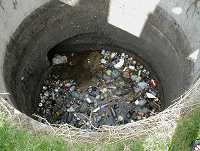|

Gross pollutant traps may catch larger items
of pollution in stormwater but removing visible
pollution gives rise to the misconception that
stormwater is clean. Other major pollutants
entering the sea through stormwater are
hydrocarbons, a variety of chemicals and
toxicants including nitrogren, as well as
suspended particles and smothering
sediments from building and construction
sites, pathogens and garden litter.
|
We become conscious of it as a cold splash in the eye or on the nose as the rain begins to fall. But what happens to those drops?
Water is a tremendous scourer. A good rainstorm washes everything. With time those small drops have the power to change landscapes. But is it all good?
Urban life can find that the nourishing rain can also become a nuisance, homes and streets may become flooded as the drops join together on their search for the lowest level. That’s why we have storm drains. Storm drains are fed by roads, car parks, driveways, and urban properties of all sorts. Storm drains themselves are made of relatively smooth and impervious surfaces that assist greatly in speeding excess water away. Where does it go - to the nearest receiving waters, creeks, rivers, lakes and inevitably the sea.
What does stormwater discharge into those waters? It loads our waters with the byproduct of our lives. Used packaging is easily seen and reviled. However, much of the pollution that enters our waterways is not quite so easily seen and less understood by most. |
Storm drains dutifully collects oils and petrochemicals from our roads, toxicants and chemicals from industries, silt and gravel from developments, pathogens from unsanitary practices and swiftly, surely sends it gushing out to meet the sea. You’ve seen the results; animals caught in plastics or dying from ingesting them, reefs smothered by silt, algal growth from excess nutrients, and ecosystems out of balance.
With more than eighty percent of our population living near the sea each city becomes it’s own ‘point source’ of damaging pollution for contaminated run-off. Times are changing, however. In Victoria eleven million dollars have been spent in the last two years to assist local government come to terms with management of stormwater and water quality emerging from stormwater drains. Intital stages saw local governments create stormwater management plans that identified the most pressing needs within each area.
The next step has been to begin to remedy those things identified as high priority. The year 2002 will see every shire and council within Victoria with a stormwater management plan. Using the Best Environmental Practice Guidelines for Urban Stormwater, these plans are helping to change the face of local government. A cultural shift is occurring in how local government thinks and acts for the environment.
Governments can help, but it is essential that the demand from the grass roots level stays keen. We love our clean water and as concerned citizens we need to act to support these sort of initiatives through changes in our own behaviour.
It may take ages of men for rain to move mountains. It only takes a few of hours to move the refuse of our lives to the sea. You can help:
Visit http://www.epa.nsw.gov.au/stormwater/whatdo/index.htm and http://www.epa.vic.gov.au/Programs/Stormwater/issues.asp for more information.
|